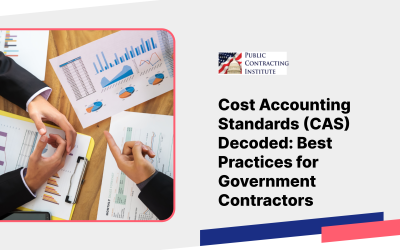*CAS 404 Capitalization of Tangible Assets. This is Part 1 of a 2-part blog. This Part 1 addresses (i) the basic fundamental requirements at CAS 404-40(a), 404-(b)(1), and 404-(b)(2); and (ii) the techniques for application at CAS 404-50(a), as well as the fundamental requirements that relate to those techniques. Part 2 of the blog will address the techniques for application at CAS 404-50(b) thru (f), as well as the fundamental requirements that relate to those techniques.
Background: This standard is primarily concerned with the measurement of costs, and the assignment of those costs to accounting periods. When a contractor purchases an item, CAS 404 provides the criteria for determining whether or not to assign the entire amount of the asset cost in the year of purchase (expense the asset), or to spread the cost over two or more years (capitalize the asset). Under the CAS definition, a tangible asset for which the cost is spread over two or more years is termed a “tangible capital asset”. CAS 404 also provides criteria for determining the cost of the tangible capital asset. Note that CAS 409, which will be the subject of a future Practical CAS blog, provides criteria for depreciating capital assets, i.e., the acceptable methods for spreading the costs of tangible capital assets over multiple years.
Fundamental Requirement at CAS 404-40(a), (b)(1), and (b)(2):
- Determining whether to expense or capitalize an asset must be based on a written policy that is reasonable and consistently applied (CAS 404-40(a)(1)). The general requirement is that assets that have a useful life of over two years and an acquisition cost in excess of $5,000 must be capitalized(CAS 404‑40(b)(1)). The contractor can have a policy with a shorter useful life and/or lower acquisition cost for capitalization, but cannot have a policy with a longer useful life of more than 2 years or an acquisition cost in excess of $5,000.
EXAMPLE: A contractor has a policy that capitalizes assets if they have a 3 year service life and a minimum acquisition cost of $2,000. This policy is in noncompliance with CAS 404, since the minimum service life is greater than 2 years.
EXAMPLE: A contractor has a policy that capitalizes assets if they have a 2 year service life and a minimum acquisition cost of $6,000. This policy is in noncompliance with CAS 404, since the minimum acquisition cost exceeds $5,000.
EXAMPLE: A contractor has a policy that capitalizes assets if they have a 2 year life and a minimum acquisition cost of $3,000. This policy complies with the requirements of CAS 404, since the minimum service life does not exceed 2 years and the minimum acquisition cost does not exceed $5,000.
**************************************************************
- The contractor’s criteria for what constitutes a tangible capital asset may, in addition to the minimum useful life and minimum acquisition cost requirements, include other specific characteristics (CAS 404‑40(b)(2)).
EXAMPLE: A contractor has a policy of capitalizing trucks with a minimum acquisition cost of $3,000 and a useful life of two years or more. The contractor also has a policy for capitalizing automobiles with a minimum acquisition cost of $5,000 and a useful life of two years or more. This practice is in compliance with CAS 404. The contractor has added a criteria based on the class of the asset, which is in addition to the CAS 404 acceptable minimum acquisition cost and minimum useful life criteria.
Techniques for Application – CAS 404-50(a)
- The acquisition cost of a tangible capital asset must be capitalized (CAS 404-40(a)). The acquisition cost equals the purchase price plus any costs necessary to prepare the asset for use (CAS 404‑50(a)).
EXAMPLE: A contractor purchases a machine for $100,000. The contractor expends $3,000 to modify the factory layout to accommodate the new machine, and $5,000 for an electrical contractor to hookup the required computer and electrical terminals. The capitalized amount of the asset is $108,000 ($100,000 + $3,000 + $5,000).
**************************************************************
- The purchase price must be adjusted to the extent practical for any premiums or extra charges paid or discounts and credits received. Capitalization of sales and use taxes and other similar costs is optional (CAS 404‑50(a)(1)).
EXAMPLE: A contractor purchases a machine. The contractor pays $53,000 cash for the machine, which includes $3,000 of sales tax. The manufacturer provides a $2,000 rebate, payable one month after purchase of the machine. The contractor can capitalize the machine at $48,000 (the $50,000 purchase price less the $2,000 rebate) or at $51,000 (the $50,000 purchase price less the $2,000 rebate plus the $3,000 sales tax). Note that the contractor’s must follow a consistent policy for capitalization, i.e., either capitalized amounts always include sales tax or they never include sales tax.
**************************************************************
- Purchase price is the cash paid. To the extent payment is not made in cash, the purchase price is an amount equivalent to what would be the cash price basis. If the cash price basis is not available, the purchase price is the current value of the consideration given in exchange for the asset (CAS 404‑50(a)(1)(i)).
EXAMPLE: A contractor purchases a truck. The contractor pays $60,000 cash for the truck. The purchase price of the truck is $60,000.
**************************************************************
- The current value of a credit instrument is the amount immediately required to settle the obligation or the amount of money which might have been raised directly through the use of the same instrument employed in making the credit purchase (CAS 404‑50(a)(1)(i)).
EXAMPLE: A contractor purchases a machine. In exchange for the machine, the contractor agrees to pay $150,000 for the machine, payable in five $30,000 annual payments. Using net present value tables to recognize the time value of money, it is determined that the value of the five annual payments on the date of purchase is $110,000. The purchase price of the machine is therefore $110,000 (it is not $150,000). Thus, the contractor must capitalize the asset at $110,000.
EXAMPLE: A contractor owns a printing press with a net book value of $150,000. The contractor gives this printing press plus cash of $300,000 in exchange for a brand new printing press that commonly sells for $400,000. The contractor capitalizes the new machine at a value of $450,000 (the net book value of the old machine plus the $300,000 cash). This is in noncompliance with CAS 404. CAS 404 requires that the contractor capitalize the new printing press in the amount of $400,000, which is the amount equivalent to what would have been the current cash price.
**************************************************************
- The current value of an equity security is its market value. Market value is the current or prevailing price of the security as indicated by recent market quotations. If such values are unavailable or inappropriate (thin market, volatile price movement, etc.), an acceptable alternative is the fair value of the asset acquired (CAS 404‑50(a)(1)(i)).
EXAMPLE: A contractor purchases a machine. In exchange for the machine, the contractor pays $2,000 cash and 3000 shares of common stock of its company. The common stock is publicly sold. As of the date of the purchase, the common stock has a price of $10 per share. The purchase price of the machine is $32,000. This represents the $2,000 cash plus the $30,000 of common stock (3,000 shares x $10 per share).
**************************************************************
- The purchase price for donated assets is their fair value as of the time they are donated (CAS 404‑50(a)(1)(ii)).
EXAMPLE: On January 1, 2002, a local organization donates a machine to the contractor. The local organization paid $100,000 for the machine two years ago. The net book value of the machine on the books of the local organization is $80,000. The fair value of the machine as of January 1, 2002, is $25,000. The contractor capitalizes the machine using the $80,000 because this was the net book value of the machine as indicated by the donating organization. This is in noncompliance with CAS 404. Under CAS 404, the purchase price of the machine is $25,000, not $80,000.
**************************************************************
- The acquisition cost also includes any costs necessary to prepare the asset for use. This includes placing the asset in location and bringing the asset to a condition necessary for normal or expected use. This includes the cost of initial inspection, testing, installation, and other expenses (CAS 404‑50(a)(2)).
EXAMPLE: The contractor purchased a new fabrication machine. The purchase price of the machine was $80,000. The contractor spent $9,000 to reconfigure the plant to accommodate the new machine, and $5,000 to install and test the machine. To comply with CAS 404, the machine must be capitalized in the amount of $94,000 ($80,000 + $9,000 + $5,000).
** Are you finding Practical CAS helpful/instructive? Please leave your comments below so that we can ensure this column is worthwhile to readers.



